SAAB 9-3 2009 Owners Manual
Manufacturer: SAAB, Model Year: 2009, Model line: 9-3, Model: SAAB 9-3 2009Pages: 304, PDF Size: 44.31 MB
Page 201 of 304
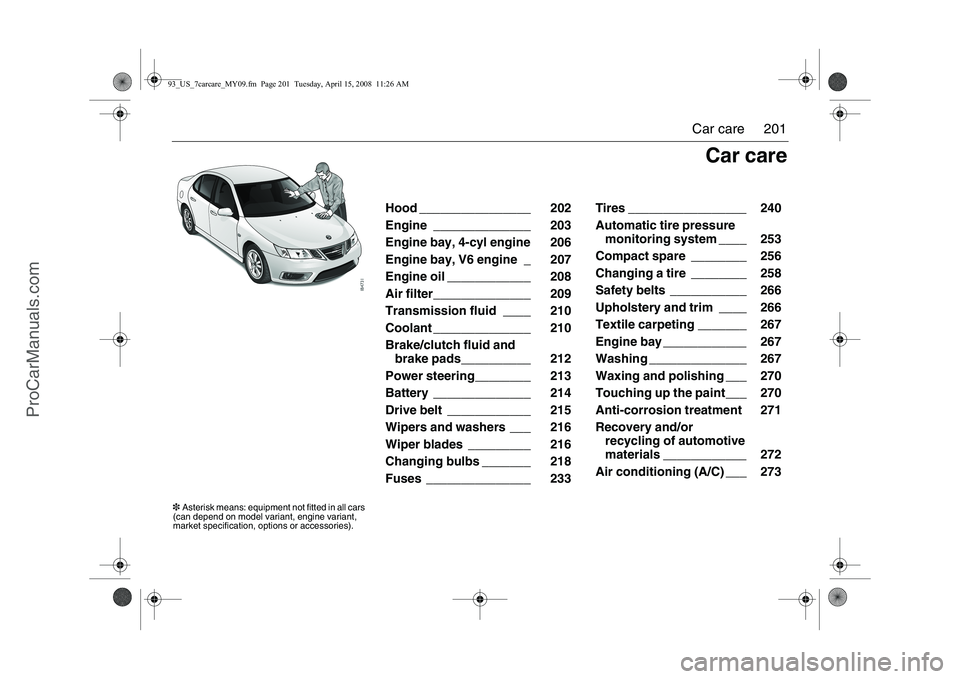
201
Car care
Hood ________________ 202
Engine ______________ 203
Engine bay, 4-cyl engine 206
Engine bay, V6 engine _ 207
Engine oil ____________ 208
Air filter______________ 209
Transmission fluid ____ 210
Coolant ______________ 210
Brake/clutch fluid and
brake pads__________ 212
Power steering________ 213
Battery ______________ 214
Drive belt ____________ 215
Wipers and washers ___ 216
Wiper blades _________ 216
Changing bulbs _______ 218
Fuses _______________ 233 Tires _________________ 240
Automatic tire pressure
monitoring system ____ 253
Compact spare ________ 256
Changing a tire ________ 258
Safety belts ___________ 266
Upholstery and trim ____ 266
Textile carpeting _______ 267
Engine bay ____________ 267
Washing ______________ 267
Waxing and polishing ___ 270
Touching up the paint___ 270
Anti-corrosion treatment 271
Recovery and/or recycling of automotive
materials ____________ 272
Air conditioning (A/C) ___ 273
Car care
3 Asterisk means: equipment not fitted in all cars
(can depend on model variant, engine variant,
market specification, options or accessories).93_US_7carcare_MY09.fm Page 201 Tuesday, April 15, 2008 11:26 AM
ProCarManuals.com
Page 202 of 304
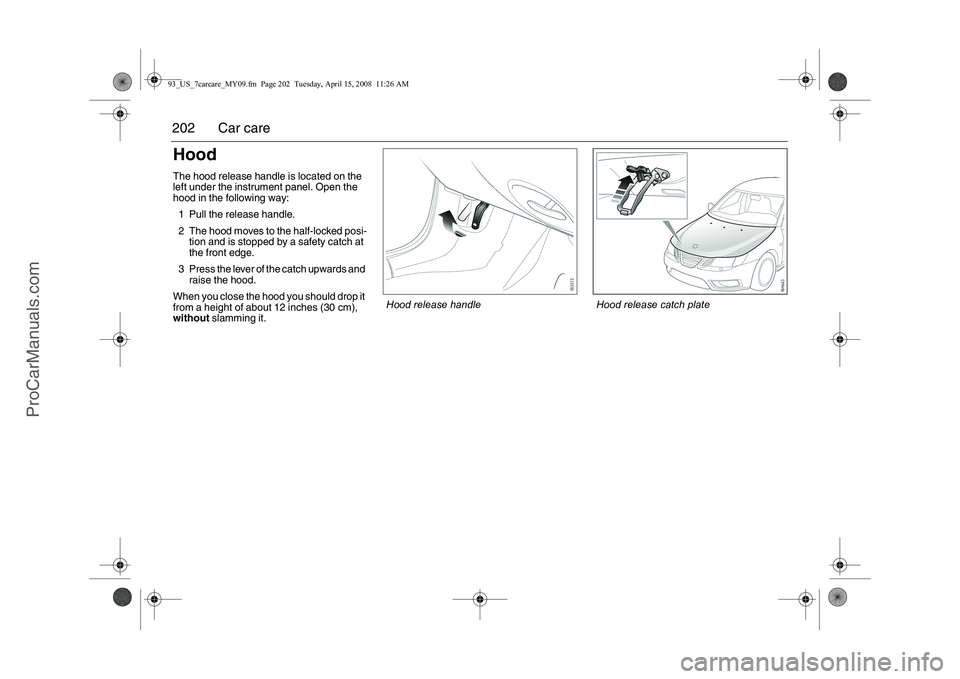
202 Car careHoodThe hood release handle is located on the
left under the instrument panel. Open the
hood in the following way:
1 Pull the release handle.
2 The hood moves to the half-locked posi- tion and is stopped by a safety catch at
the front edge.
3 Press the lever of the catch upwards and raise the hood.
When you close the hood you should drop it
from a height of about 12 inches (30 cm),
without slamming it.
Hood release catch plate
Hood release handle
93_US_7carcare_MY09.fm Page 202 Tuesday, April 15, 2008 11:26 AM
ProCarManuals.com
Page 203 of 304
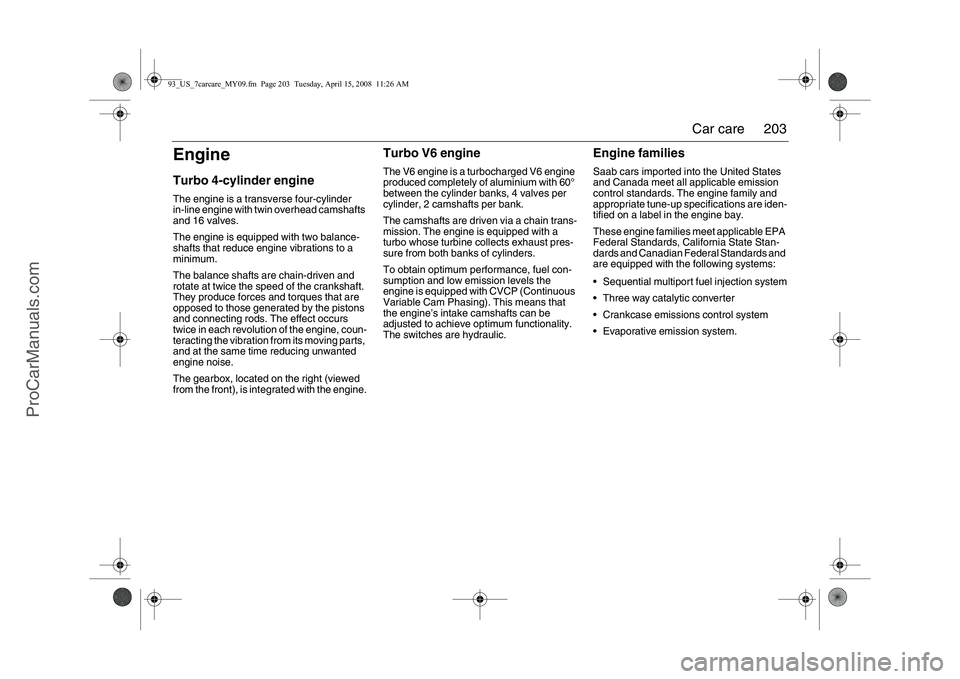
203
Car care
EngineTurbo 4-cylinder engineThe engine is a transverse four-cylinder
in-line engine with twin overhead camshafts
and 16 valves.
The engine is equipped with two balance-
shafts that reduce engine vibrations to a
minimum.
The balance shafts are chain-driven and
rotate at twice the speed of the crankshaft.
They produce forces and torques that are
opposed to those generated by the pistons
and connecting rods. The effect occurs
twice in each revolution of the engine, coun-
teracting the vibration from its moving parts,
and at the same time reducing unwanted
engine noise.
The gearbox, located on the right (viewed
from the front), is integrated with the engine.
Turbo V6 engineThe V6 engine is a turbocharged V6 engine
produced completely of aluminium with 60°
between the cylinder banks, 4 valves per
cylinder, 2 camshafts per bank.
The camshafts are driven via a chain trans-
mission. The engine is equipped with a
turbo whose turbine collects exhaust pres-
sure from both banks of cylinders.
To obtain optimum performance, fuel con-
sumption and low emission levels the
engine is equipped with CVCP (Continuous
Variable Cam Phasing). This means that
the engine’s intake camshafts can be
adjusted to achieve optimum functionality.
The switches are hydraulic.
Engine familiesSaab cars imported into the United States
and Canada meet all applicable emission
control standards. The engine family and
appropriate tune-up specifications are iden-
tified on a label in the engine bay.
These engine families meet applicable EPA
Federal Standards, Ca lifornia State Stan-
dards and Canadian Federal Standards and
are equipped with the following systems:
Sequential multiport fuel injection system
Three way catalytic converter
Crankcase emissi ons control system
Evaporative emission system.
93_US_7carcare_MY09.fm Page 203 Tuesday, April 15, 2008 11:26 AM
ProCarManuals.com
Page 204 of 304
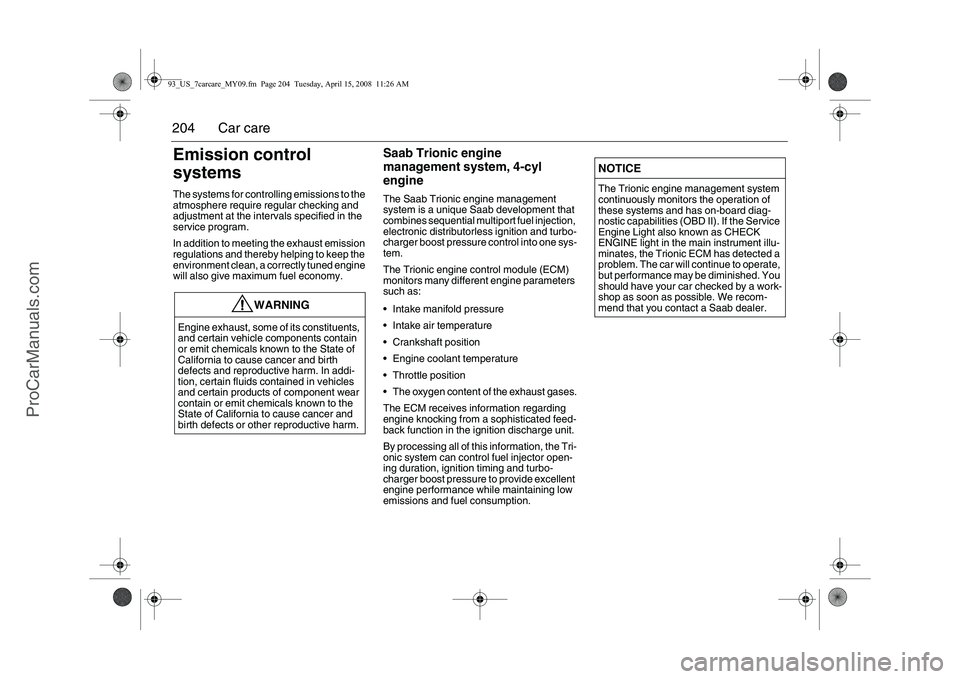
204 Car careEmission control
systemsThe systems for controlling emissions to the
atmosphere require regular checking and
adjustment at the intervals specified in the
service program.
In addition to meeting the exhaust emission
regulations and thereby helping to keep the
environment clean, a correctly tuned engine
will also give maximum fuel economy.
Saab Trionic engine
management system, 4-cyl
engineThe Saab Trionic engine management
system is a unique Saab development that
combines sequential mult iport fuel injection,
electronic distributorless ignition and turbo-
charger boost pressure control into one sys-
tem.
The Trionic engine control module (ECM)
monitors many different engine parameters
such as:
Intake manifold pressure
Intake air temperature
Crankshaft position
Engine coolant temperature
Throttle position
The oxygen content of the exhaust gases.
The ECM receives information regarding
engine knocking from a sophisticated feed-
back function in the ignition discharge unit.
By processing all of this information, the Tri-
onic system can control fuel injector open-
ing duration, ignition timing and turbo-
charger boost pressure to provide excellent
engine performance while maintaining low
emissions and fuel consumption.
WARNING
Engine exhaust, some of its constituents,
and certain vehicle components contain
or emit chemicals known to the State of
California to cause cancer and birth
defects and reproductive harm. In addi-
tion, certain fluids contained in vehicles
and certain products of component wear
contain or emit chemicals known to the
State of California to cause cancer and
birth defects or other reproductive harm.
NOTICEThe Trionic engine management system
continuously monitors the operation of
these systems and has on-board diag-
nostic capabilities (OBD II). If the Service
Engine Light also known as CHECK
ENGINE light in the main instrument illu-
minates, the Trionic ECM has detected a
problem. The car will continue to operate,
but performance may be diminished. You
should have your car checked by a work-
shop as soon as possible. We recom-
mend that you contact a Saab dealer.
93_US_7carcare_MY09.fm Page 204 Tuesday, April 15, 2008 11:26 AM
ProCarManuals.com
Page 205 of 304
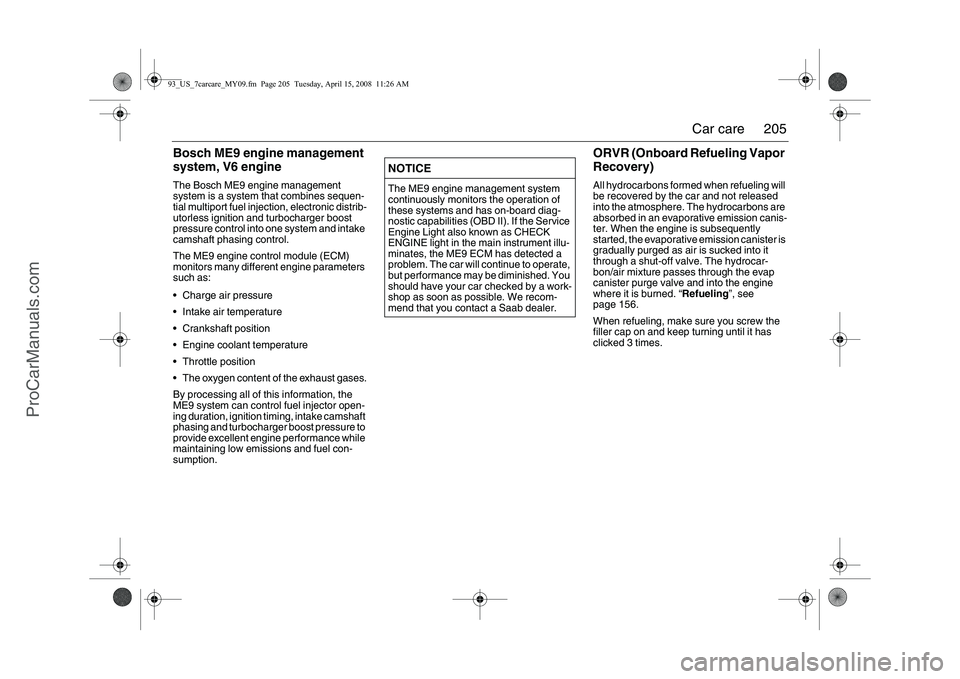
205
Car care
Bosch ME9 engine management
system, V6 engineThe Bosch ME9 engine management
system is a system that combines sequen-
tial multiport fuel injection, electronic distrib-
utorless ignition and turbocharger boost
pressure control into one system and intake
camshaft phasing control.
The ME9 engine control module (ECM)
monitors many different engine parameters
such as:
Charge air pressure
Intake air temperature
Crankshaft position
Engine coolant temperature
Throttle position
The oxygen content of the exhaust gases.
By processing all of this information, the
ME9 system can contro l fuel injector open-
ing duration, ignition timing, intake camshaft
phasing and turbocharger boost pressure to
provide excellent engine performance while
maintaining low emissions and fuel con-
sumption.
ORVR (Onboard Refueling Vapor
Recovery)All hydrocarbons formed when refueling will
be recovered by the car and not released
into the atmosphere. The hydrocarbons are
absorbed in an evaporative emission canis-
ter. When the engine is subsequently
started, the evaporative emission canister is
gradually purged as air is sucked into it
through a shut-off va lve. The hydrocar-
bon/air mixture passes through the evap
canister purge valve and into the engine
where it is burned. “ Refueling”, see
page 156.
When refueling, make sure you screw the
filler cap on and keep turning until it has
clicked 3 times.
NOTICEThe ME9 engine management system
continuously monitors the operation of
these systems and has on-board diag-
nostic capabilities (OBD II). If the Service
Engine Light also known as CHECK
ENGINE light in the main instrument illu-
minates, the ME9 ECM has detected a
problem. The car will continue to operate,
but performance may be diminished. You
should have your car checked by a work-
shop as soon as possible. We recom-
mend that you contact a Saab dealer.
93_US_7carcare_MY09.fm Page 205 Tuesday, April 15, 2008 11:26 AM
ProCarManuals.com
Page 206 of 304
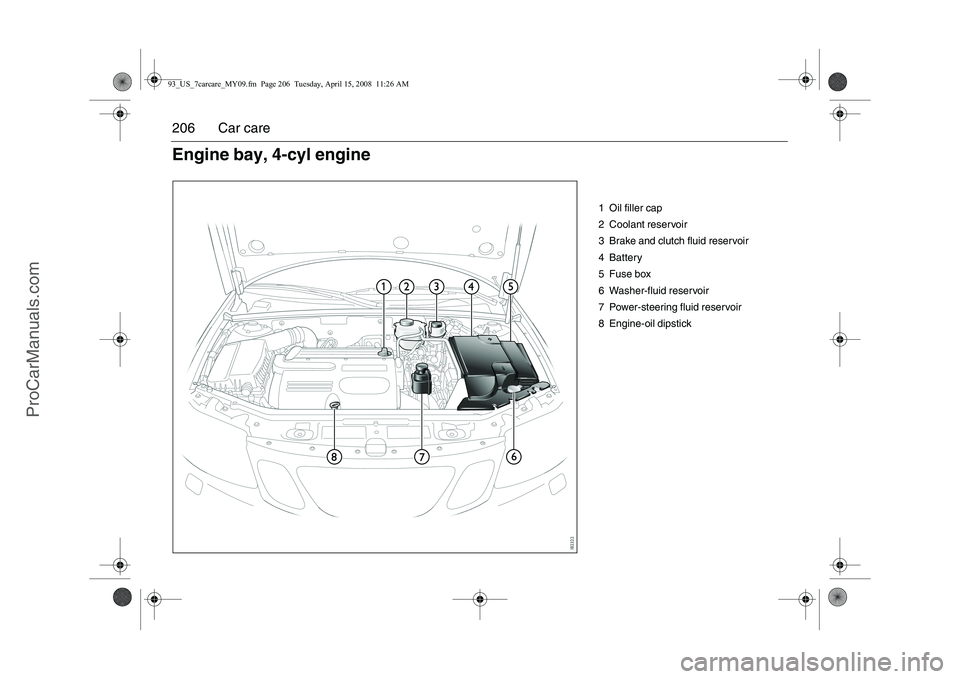
206 Car care
1 Oil filler cap
2 Coolant reservoir
3 Brake and clutch fluid reservoir
4Battery
5 Fuse box
6 Washer-fluid reservoir
7 Power-steering fluid reservoir
8 Engine-oil dipstick
Engine bay, 4-cyl engine93_US_7carcare_MY09.fm Page 206 Tuesday, April 15, 2008 11:26 AM
ProCarManuals.com
Page 207 of 304
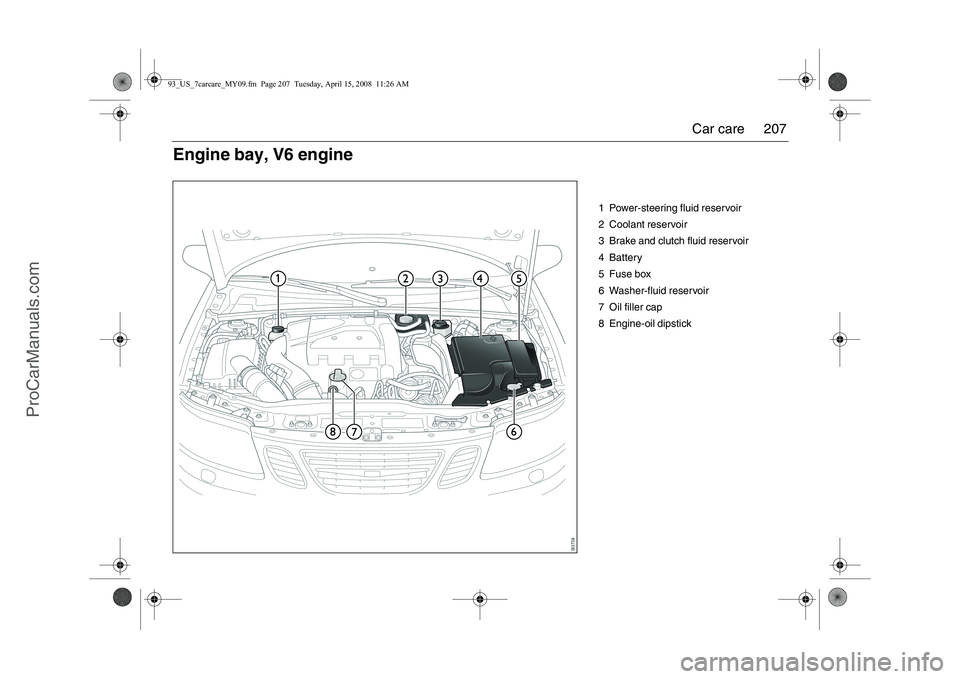
207
Car care
1 Power-steering fluid reservoir
2 Coolant reservoir
3 Brake and clutch fluid reservoir
4Battery
5 Fuse box
6 Washer-fluid reservoir
7 Oil filler cap
8 Engine-oil dipstick
Engine bay, V6 engine93_US_7carcare_MY09.fm Page 207 Tuesday, April 15, 2008 11:26 AM
ProCarManuals.com
Page 208 of 304
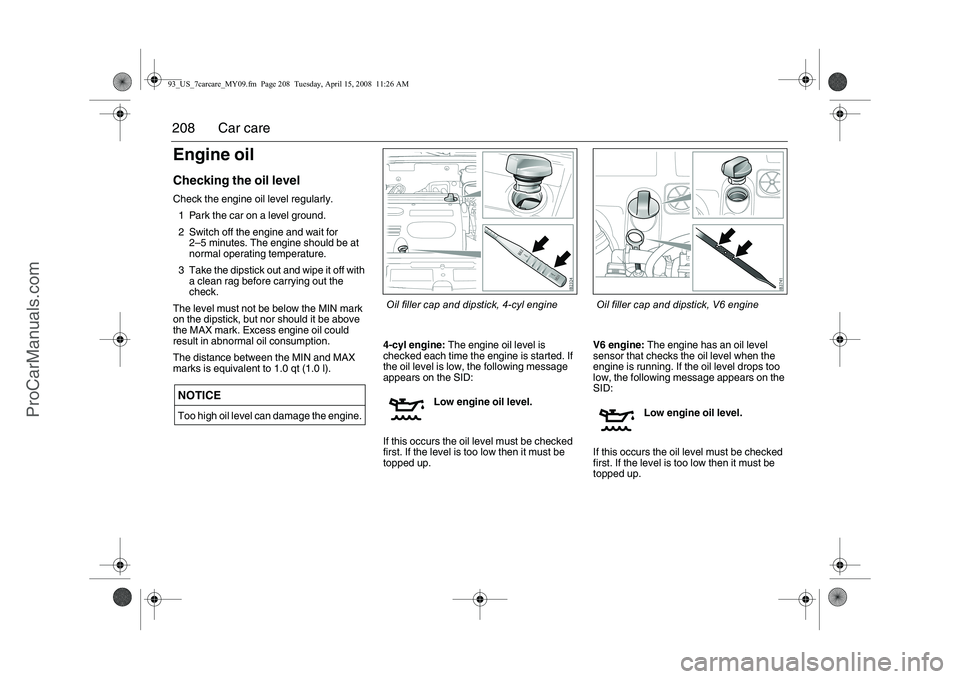
208 Car careEngine oilChecking the oil levelCheck the engine oil level regularly.1 Park the car on a level ground.
2 Switch off the engine and wait for 2–5 minutes. The engine should be at
normal operating temperature.
3 Take the dipstick out and wipe it off with a clean rag before carrying out the
check.
The level must not be below the MIN mark
on the dipstick, but nor should it be above
the MAX mark. Excess engine oil could
result in abnormal oil consumption.
The distance between the MIN and MAX
marks is equivalent to 1.0 qt (1.0 l). 4-cyl engine:
The engine oil level is
checked each time the engine is started. If
the oil level is low, the following message
appears on the SID:
If this occurs the oil level must be checked
first. If the level is too low then it must be
topped up. V6 engine:
The engine has an oil level
sensor that checks t he oil level when the
engine is running. If the oil level drops too
low, the following message appears on the
SID:
If this occurs the oil level must be checked
first. If the level is too low then it must be
topped up.NOTICEToo high oil level can damage the engine.
Low engine oil level.
Low engine oil level.
Oil filler cap and dipstick, 4-cyl engine
Oil filler cap and dipstick, V6 engine
93_US_7carcare_MY09.fm Page 208 Tuesday, April 15, 2008 11:26 AM
ProCarManuals.com
Page 209 of 304
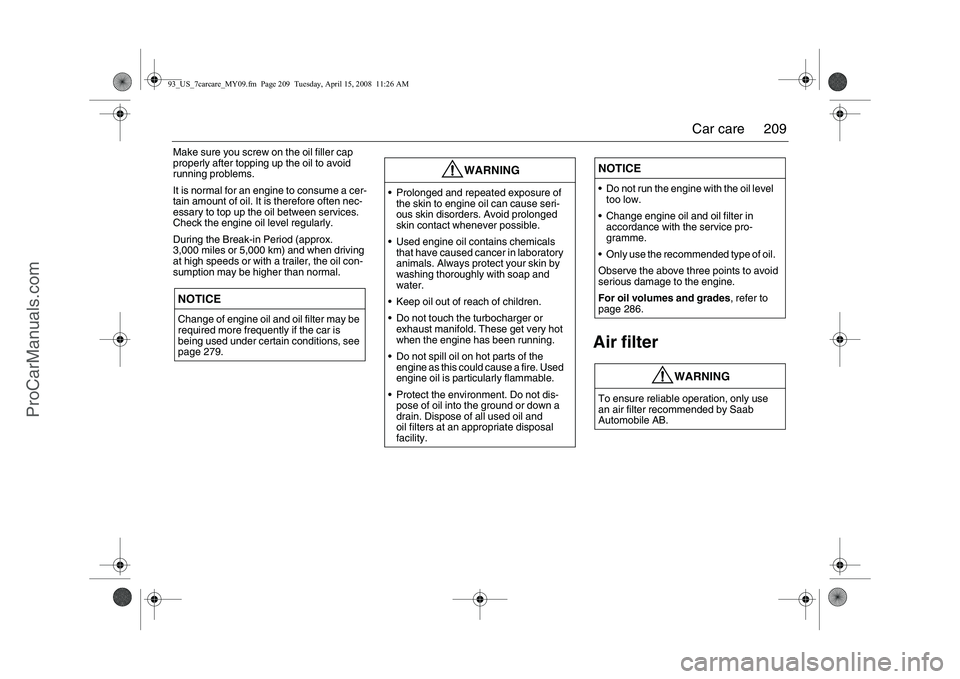
209
Car care
Make sure you screw on the oil filler cap
properly after topping up the oil to avoid
running problems.
It is normal for an engine to consume a cer-
tain amount of oil. It is therefore often nec-
essary to top up the oil between services.
Check the engine oil level regularly.
During the Break-in Period (approx.
3,000 miles or 5,000 km) and when driving
at high speeds or with a trailer, the oil con-
sumption may be higher than normal.
Air filter
NOTICEChange of engine oil and oil filter may be
required more frequently if the car is
being used under certain conditions, see
page 279.
WARNING
Prolonged and repeated exposure of the skin to engine oil can cause seri-
ous skin disorders. Avoid prolonged
skin contact whenever possible.
Used engine oil contains chemicals that have caused cancer in laboratory
animals. Always protect your skin by
washing thoroughly with soap and
water.
Keep oil out of reach of children.
Do not touch the turbocharger or exhaust manifold. These get very hot
when the engine has been running.
Do not spill oil on hot parts of the engine as this could cause a fire. Used
engine oil is particularly flammable.
Protect the environment. Do not dis- pose of oil into the ground or down a
drain. Dispose of all used oil and
oil filters at an appropriate disposal
facility.
NOTICE Do not run the engine with the oil level too low.
Change engine oil and oil filter in accordance with the service pro-
gramme.
Only use the recommended type of oil.
Observe the above three points to avoid
serious damage to the engine.
For oil volumes and grades , refer to
page 286.
WARNING
To ensure reliable operation, only use
an air filter recommended by Saab
Automobile AB.
93_US_7carcare_MY09.fm Page 209 Tuesday, April 15, 2008 11:26 AM
ProCarManuals.com
Page 210 of 304
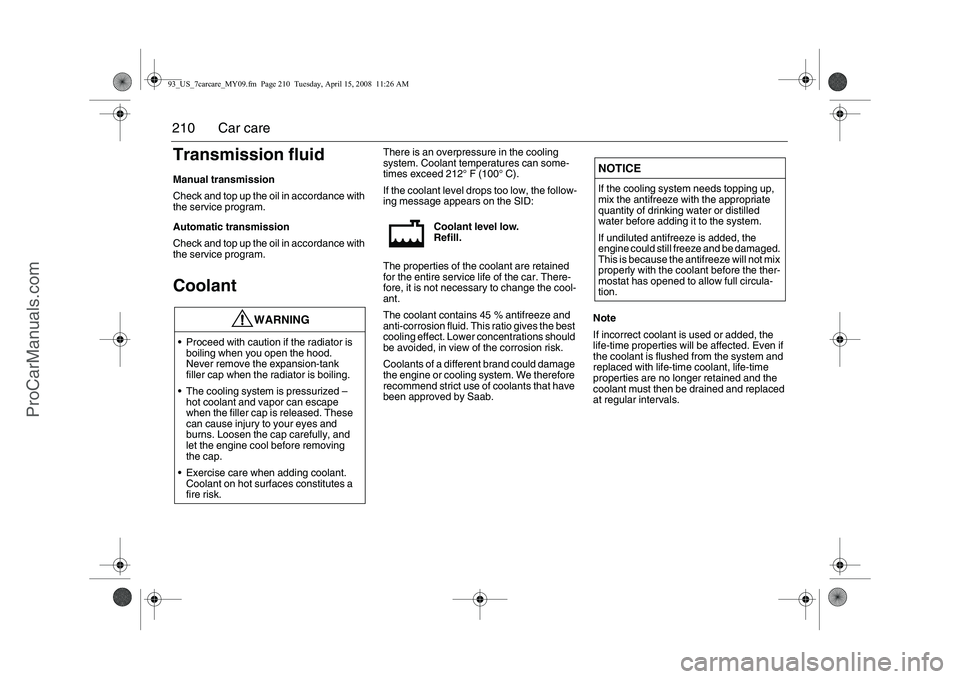
210 Car careTransmission fluidManual transmission
Check and top up the oil in accordance with
the service program.
Automatic transmission
Check and top up the oil in accordance with
the service program.Coolant
There is an overpressu re in the cooling
system. Coolant temper atures can some-
times exceed 212° F (100° C).
If the coolant level drops too low, the follow-
ing message appears on the SID:
The properties of the coolant are retained
for the entire service life of the car. There-
fore, it is not necessary to change the cool-
ant.
The coolant contains 45 % antifreeze and
anti-corrosion fluid. This ratio gives the best
cooling effect. Lower concentrations should
be avoided, in view of the corrosion risk.
Coolants of a different brand could damage
the engine or cooling system. We therefore
recommend strict use of coolants that have
been approved by Saab. Note
If incorrect coolant is used or added, the
life-time properties will be affected. Even if
the coolant is flushed from the system and
replaced with life-time coolant, life-time
properties are no longer retained and the
coolant must then be drained and replaced
at regular intervals.
WARNING
Proceed with caution if the radiator is
boiling when you open the hood.
Never remove the expansion-tank
filler cap when the radiator is boiling.
The cooling system is pressurized – hot coolant and vapor can escape
when the filler cap is released. These
can cause injury to your eyes and
burns. Loosen the cap carefully, and
let the engine cool before removing
the cap.
Exercise care when adding coolant. Coolant on hot surfaces constitutes a
fire risk.
Coolant level low.
Refill.
NOTICEIf the cooling system needs topping up,
mix the antifreeze with the appropriate
quantity of drinking water or distilled
water before adding it to the system.
If undiluted antifreeze is added, the
engine could still freeze and be damaged.
This is because the antifreeze will not mix
properly with the coolant before the ther-
mostat has opened to allow full circula-
tion.
93_US_7carcare_MY09.fm Page 210 Tuesday, April 15, 2008 11:26 AM
ProCarManuals.com